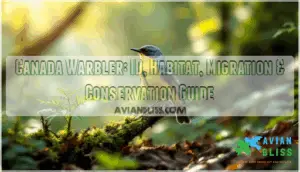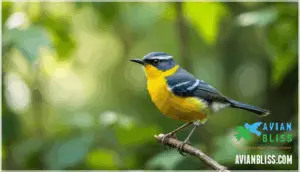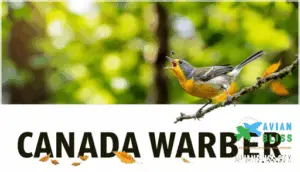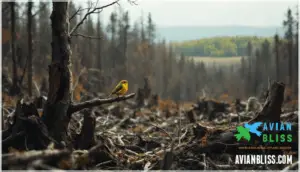This site is supported by our readers. We may earn a commission, at no cost to you, if you purchase through links.
 A bird wearing a necklace sounds like something from a children’s book, but the Canada warbler sports exactly that—a striking collar of black streaks across its bright yellow breast. This small songbird, no bigger than your palm, has become something of a ghost in North American forests, its population cut nearly in half since 1970.
A bird wearing a necklace sounds like something from a children’s book, but the Canada warbler sports exactly that—a striking collar of black streaks across its bright yellow breast. This small songbird, no bigger than your palm, has become something of a ghost in North American forests, its population cut nearly in half since 1970.
The Canada warbler’s decline tells a larger story about disappearing wetlands and fragmented woodlands, yet most people have never seen one darting through the shadowy understory where it hunts insects with acrobatic precision.
Understanding this energetic flycatcher—from its bold markings to its marathon migrations between Canadian forests and Andean slopes—reveals what’s at stake when forest habitats vanish.
Table Of Contents
- Key Takeaways
- What is The Canada Warbler?
- Where Do Canada Warblers Live?
- Migration and Seasonal Movements
- Diet, Feeding, and Nesting Habits
- Conservation Status and How to Help
- Frequently Asked Questions (FAQs)
- What is a Canada warbler?
- Where do Canada warblers live?
- Why is the Canada warbler difficult to observe in Canada?
- How do I find a Canada warbler?
- Are Canada warblers endangered?
- Are prairie warblers common in Canada?
- Are Canada warblers rare?
- Where do Canada warblers migrate?
- What birds are similar to the Canada warbler?
- How did Canada warbler get its name?
- Conclusion
Key Takeaways
- Canada Warblers have declined by 51% since 1970, primarily due to habitat loss in both their North American breeding grounds (where dense understory and wetland edges are disappearing) and their Andean wintering areas (where over 90% of mountain forests have been cleared).
- These small songbirds are expert flycatchers that hunt insects with acrobatic precision in the forest understory, playing a crucial role in controlling beetle, mosquito, and caterpillar populations while serving as indicators of healthy forest ecosystems.
- The species undertakes demanding long-distance migrations between Canadian boreal forests and Colombian Andes, arriving late in spring and departing early in fall, which leaves them vulnerable to habitat degradation at stopover sites and makes them sensitive to climate impacts.
- Conservation efforts show some success, with Canadian populations recovering 46% between 2009 and 2019, though long-term threats remain serious—individuals can help by preserving native vegetation, buying bird-friendly coffee, installing window strike prevention, and participating in citizen science monitoring projects.
What is The Canada Warbler?
The Canada Warbler is a small songbird that stands out in the forest understory with its bold markings and energetic movements. Understanding what makes this species unique starts with knowing how scientists classify it, what it looks like, and how it behaves in the wild.
Let’s break down the key features that help you identify and appreciate this declining warbler.
Scientific Classification and Naming
If you’ve ever wondered about the Canada Warbler’s place in the bird world, you’ll find it sits comfortably within the Parulidae family—better known as the wood-warblers—and carries the scientific name Cardellina canadensis. This places it in the order Passeriformes, which includes all perching birds.
The genus Cardellina groups it with other ground-loving warblers, reflecting its preference for low, mossy understory habitats. While there’s no subspecies debate for this species, genetic analysis confirms its distinct position among North American warblers.
Physical Description and Identification Features
Once you know where the Canada Warbler belongs on the family tree, spotting one in the field becomes much easier when you focus on its most striking feature—a bold black necklace of streaks splashed across a bright yellow breast. This plumage detail really makes the bird pop against the forest understory.
You’ll also notice a prominent white eyering circling each eye, sharp enough to catch even from a distance. The upper parts show steely blue-gray coloring, and there’s no wing-bars or tail spots to confuse you—just a rounded, square-tipped tail.
Unique Behaviors and Traits
Beyond its eye-catching plumage, you’ll spot the Canada Warbler by its energetic movements and restless foraging behavior. These birds are always on the move, flicking their wings and tail as they hop between branches.
They’re expert flycatchers, flushing insects from foliage and catching them mid-air—a skill that sets them apart from most warblers. You’ll also find them searching the ground among fallen leaves for beetles, mosquitoes, spiders, and caterpillars.
Their overwintering population resides in the Colombian Andes. Try pishing or squeaking sounds near suitable habitat; Canada Warblers respond strongly, often popping into view to investigate.
Where Do Canada Warblers Live?
If you want to spot a Canada Warbler, you’ll need to know where to look. These birds have specific preferences regarding their homes, and their locations shift dramatically with the seasons.
Let’s explore the breeding grounds, wintering destinations, and the key habitat features that make a place feel like home for these necklaced warblers.
Breeding Range and Preferred Habitats
You’ll find Canada Warblers across a vast breeding range—roughly 80% in Canada, from southeastern Yukon to the Maritimes, with the rest reaching northern Georgia through the Appalachians. They favor moist deciduous forests with dense understory vegetation, particularly near wetland edges and slopes above 600 meters elevation.
Habitat fragmentation and wetland loss threaten these breeding grounds, while forest succession reducing understory vegetation limits suitable breeding habitat. Regional variation shows highest abundance in Ontario, Quebec, and New Brunswick’s Warbler habitat.
The Breeding Bird Survey data indicates a significant decline in Warbler populations.
Wintering Grounds in South America
When winter arrives, you’ll find Canada Warblers thousands of miles south in the northern Andes of South America—primarily in Colombia, Ecuador, Peru, and Venezuela. These neotropical migrants settle between 1,000–2,200 meters elevation, favoring humid montane and cloud forests.
Deforestation impact threatens wintering populations concentrated across roughly 214,000 km². Conservation efforts protect about half this range, though habitat preference for mature forest makes them vulnerable to ongoing land conversion in their South American wintering grounds.
Key Habitat Features and Microhabitats
Whether you’re scanning a boreal bog or a misty Appalachian hollow, Canada Warblers rely on a few critical habitat features that define their summer homes. These warblers favor habitat patches mixing conifer and deciduous trees, often near standing water.
Look for dense understory vegetation—especially ferns and rhododendrons—along with mossy groundcover that creates their preferred forest undergrowth. That shrub layer becomes essential warbler habitat where they nest on slightly raised ground and hunt insects through the forest understory.
Migration and Seasonal Movements
Canada Warblers are long-distance travelers, journeying thousands of miles between their breeding and wintering grounds each year. Understanding their migration helps you know when and where to look for these birds throughout the seasons.
Let’s explore the patterns, timing, and behaviors that define their striking seasonal movements.
Spring and Fall Migration Patterns
Canada Warblers follow a predictable but demanding migration schedule that shapes their entire year. You’ll notice these striking birds are among the last warblers to arrive north in spring and the first to depart in fall, spending remarkably little time on their breeding grounds.
Their migration patterns reveal fascinating stopover ecology, with weather impacts influencing route variations as they travel between northern forests and South American wintering grounds.
- Late spring arrivals: Canada Warblers reach breeding territories after most other warbler species, reducing competition
- Early fall departures: They begin southward migration while summer still lingers, showing precise biological timing
- Mixed-species flocks: During migration, they often travel alongside Wilson’s Warblers and other small songbirds
- Stopover dependence: These birds rely heavily on quality habitat patches to refuel during their long journey
- Weather-driven adjustments: Wind patterns and storm systems can alter their migratory routes considerably each season
Timing and Routes of Migration
Understanding when these birds travel—and the paths they take—can help you time your birdwatching trips and appreciate just how impressive their journey really is. Spring arrival usually occurs in late May, while fall departure begins as early as mid-July.
Canada Warblers follow migration routes through the eastern United States, relying on stopover habitats with dense understory vegetation. Climate impacts increasingly affect their timing, making conservation of migratory bird habitat essential for these long-distance travelers.
Flocking and Migratory Behavior
During migration, you’ll often spot Canada Warblers traveling in mixed flocks with other warbler species, a survival strategy that offers extra eyes for finding food and avoiding predators. Wilson’s Warblers are common companions during these nocturnal migrations.
You can attract them using pishing sounds at stopover sites—they respond eagerly, giving you great views of these energetic travelers as they refuel before continuing their journey south.
Diet, Feeding, and Nesting Habits
Canada Warblers are expert insect hunters with unique feeding habits and nesting preferences that reflect their life in the forest understory. Understanding what they eat, how they forage, and where they raise their young gives you insight into why healthy, undisturbed forests matter so much to these birds.
Let’s look at the key aspects of their diet, foraging behavior, and nesting strategies.
Insectivorous Diet and Foraging Techniques
If you watch a Canada Warbler for even a few minutes, you’ll notice it’s a busy little acrobat—constantly flicking its wings and tail while snatching insects from the air with impressive precision. This insectivorous diet includes beetles, mosquitoes, spiders, and smooth caterpillars like cankerworms.
You’ll see it practicing flycatching methods more than most warblers, flushing flying insects from foliage while also searching through fallen leaves during ground foraging, showing considerable foraging efficiency throughout its feeding behavior.
Nesting Locations and Reproductive Behavior
When it’s time to raise their young, these energetic warblers settle down and build their nests right on the forest floor—usually tucked into slightly raised spots like moss-covered logs or grassy hummocks.
You’ll find their nest material includes leaves, grasses, and moss carefully woven together. The female usually lays a clutch size of four to five eggs, performing most incubation duties for about 12 days.
Both parents provide parental care once the eggs hatch, boosting fledgling success rates.
Role in Forest Ecosystems
Beyond just raising children, Canada Warblers earn their keep in the forest by helping to keep insect populations in check. Here’s how they contribute to forest ecosystem dynamics:
- Insect control – They consume beetles, mosquitoes, and caterpillars, reducing pest outbreaks in forest undergrowth.
- Nutrient cycling – Their foraging activity moves nutrients from insects back into the soil through droppings.
- Habitat indicator – Their presence signals healthy forest ecosystems with intact understory, warning against forest fragmentation.
Conservation Status and How to Help
The Canada Warbler faces real challenges that threaten its survival, but there’s good news—conservation efforts are already underway, and you can play a part in helping this species.
Understanding the current threats and population trends helps us see why action matters. Let’s look at what’s happening with Canada Warbler numbers and what steps are being taken to protect them.
Population Trends and Major Threats
Though recent data show recovery signals, with Canadian populations climbing 46% between 2009 and 2019, Canada Warblers face serious conservation challenges. Long-term population declines remain steep—down 51% since 1970 in Canada.
Despite a 46% recovery since 2009, Canada Warblers still face steep long-term decline, down 51% since 1970
Threats to conservation include dramatic winter habitat loss in the Andes, where over 90% of mountain forests have been cleared. Demographic factors like reduced adult survival drive declining populations more than breeding issues. Additional threats include building collisions, nest predation, and shrinking insect prey.
Impact of Habitat Loss and Fragmentation
Habitat loss and forest fragmentation hit Canada Warblers especially hard because they need large, intact forests with healthy understory vegetation. You’ll see the damage play out in several ways:
- Forest clearing destroys both breeding grounds in North America and critical wintering habitat in South American mountains
- Logging effects remove the mixed conifer-deciduous forests these birds depend on for nesting
- Understory impact from deer browsing eliminates the shrubby layer where warblers forage and nest
- Fragmentation effects create smaller forest patches that expose nests to more predators and parasites
- Habitat degradation from pollution and development reduces insect populations that fuel their diet
This combination drives the steep population decline—down 3.2% yearly across their breeding range—pushing their conservation status into urgent territory.
Ongoing Conservation Efforts and How You Can Help
Conservation initiatives across the Americas are working to protect Canada Warblers through habitat restoration, policy implementation, and citizen science. The Canada Warbler International Conservation Initiative, launched in 2013, coordinates efforts to secure breeding forests and wintering grounds—over 23 reserves now protect migration and winter habitats in Latin America.
You can help through public participation: preserve native vegetation on your property, buy bird-friendly coffee, report sightings to monitoring projects, and install window strike prevention measures during migration to reduce threats and support avian conservation.
Frequently Asked Questions (FAQs)
What is a Canada warbler?
A Canada Warbler is a small songbird in the Parulidae family, known for its striking black necklace pattern across a yellow breast, blue-gray upperparts, and bold eye-ring.
These distinctive features make warbler identification easier for birdwatchers exploring North American forests.
Where do Canada warblers live?
Picture a misty northern forest floor carpeted in moss and ferns—that’s where you’ll find Canada Warblers during breeding season.
These birds prefer moist, shady woodlands with dense understory vegetation across Canada and the northeastern United States, extending south through the Appalachian Mountains to Georgia.
Why is the Canada warbler difficult to observe in Canada?
You’ll find yourself challenged by their declining numbers and specific habitat needs.
These warblers stick to dense understory within northern forests, favoring shrub layers and forest undergrowth that make observation difficult even for skilled observers.
How do I find a Canada warbler?
Scrolling through range maps on your phone, you’ll see these birds favor moist forests with shrubby understory—think mossy ground and ferns.
Listen for their distinctive song during spring migration. Use habitat clues and vocalizations for ethical birding success.
Are Canada warblers endangered?
While not officially endangered, Canada Warblers face serious population decline—dropping 2% annually. Habitat loss and fragmentation are key threats.
Conservation efforts focus on habitat protection to secure warbler population decline and their future outlook.
Are prairie warblers common in Canada?
No, Prairie Warblers are quite rare in Canada. They breed mainly in the eastern United States and only reach southern Ontario, creating minimal habitat overlap with Canada Warblers.
These species prefer different environments, reducing identification challenges.
Are Canada warblers rare?
Yes, they’re becoming increasingly rare. Population decline rates hit 2 percent annually, driven by habitat loss and fragmentation.
Conservation efforts focus on protecting breeding grounds and securing suitable habitats to reverse this troubling trend.
Where do Canada warblers migrate?
Like turning back the clock on a telegraph line, these warblers undertake nocturnal migrations from northern breeding grounds through stopover locations to South American wintering habitats.
Migration patterns face climate impacts and challenges, yet their winter survival depends on completing this noteworthy journey twice yearly.
What birds are similar to the Canada warbler?
Wilson’s Warbler shares yellow plumage and understory habits, while Mourning Warbler has similar gray tones. Kentucky Warbler also features yellow underparts with dark markings.
These confusing species require careful observation of field marks like eyerings, necklace patterns, and regional differences for accurate avian identification during warbler migration.
How did Canada warbler get its name?
The Canada Warbler’s name reflects its breeding range, as the species was first described from specimens collected in Canada, where about 75% of the global population still nests today.
Conclusion
Like catching a glimpse of sunlight flickering through dense forest shadows, spotting a Canada warbler requires patience and a bit of luck. These yellow-breasted songbirds with their distinctive necklace markings depend on healthy wetland forests to survive.
By protecting their breeding grounds, supporting conservation initiatives, and reducing pesticide use in your own backyard, you’re helping guarantee future generations won’t lose this acrobatic insect hunter to history. Every small action creates ripples that reach from Canadian woodlands to Andean mountainsides.










